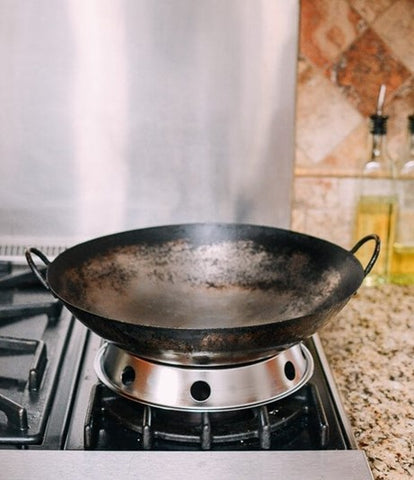- Finance
-
Equipment
- Beverage
- Coffee
-
Cooking
- Shop all cooking
- Bratt pans
- Char grills
- Chicken rotisseries
- Combi ovens
- Contact grills
- Convection ovens
- Conveyor toasters
- Cooktops
- Cooktop oven combos
- Crepe and pancake makers
- Deck ovens
- Fryers and oil filters
- Griddles
- Kebab machines
- Microwaves
- Pasta cookers
- Pizza ovens
- Range ovens
- Rice cookers
- Salamander grills
- Sous vide
- Speed ovens
- Steamers
- Tandoor ovens
- Toaster grills
- Waffle makers
- Wok burners
- Other
- Dishwashers
- Food display
- Food preparation
- Stainless steel
- Laundry
- Point of sale
-
Refrigeration
- Shop all refrigeration
- Blast chillers
- Chest freezers
- Countertop fridges
- Display freezers
- Display fridges
- Gelato freezers
- Ice-cream machines
- Ice machines
- Pizza prep fridges
- Refrigerated drawers
- Sandwich prep fridges
- Slushie machines
- Under counter freezers
- Under counter fridges
- Upright freezers
- Upright fridges
- Other
- Restaurant furniture
- Shop all equipment
- Customers
- FAQs
- Resources
- About Us
Share
Best commercial wok burners: Buyer’s Guide
article
What's inside this buyer's guide
- Introduction
- Types of commercial wok burners
- Styles of commercial wok burners
- Things to consider before purchase
- Best makes of commercial wok burners
- Used commercial wok burners — worth considering?
- Frequently asked questions
- Commercial wok burner glossary
- Keep your cash, use ours!
A wok burner is not just a stove. It's a beast.
It can blast out intense heat, handle massive amounts of food, and switch between different cooking styles. Whether you want to toss, fry, steam, or stew, a wok burner can do it all.
But how do you choose the best commercial wok burner for your kitchen? In this buyer's guide, we will help you find the answer.
We will cover the different types of wok burners, the features to look for, the benefits and drawbacks of each option, and some tips on how to use and maintain your wok burner.
By the end of this guide, you will be ready to make an informed decision and buy the perfect wok burner for your needs.
Types of commercial wok burners
The type of wok burner you choose will affect the performance, efficiency, and safety of your cooking.
There are five main types of commercial wok burners: low-pressure, high-pressure, stockpot, wok range, and waterless wok burners.
Let's take a closer look at each type and see what they offer.
Low-pressure wok burners
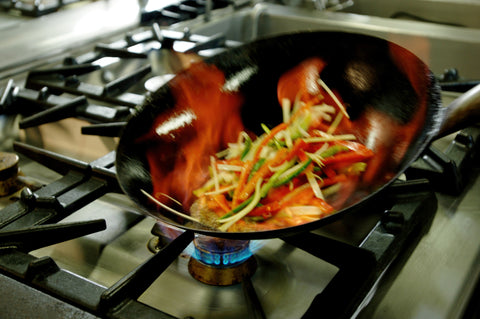
Low-pressure wok burners are a popular and cost-effective choice in the world of commercial cooking.
These burners operate at a low pressure of about 3.45 kilopascals and are fuelled by either natural gas or propane.
Their design is straightforward, making them user-friendly and easy to install.
Capable of producing heat ranging from 10,000 to 40,000 BTU per hour, they are well-suited for small to medium-sized woks and can efficiently perform basic cooking tasks such as stir-frying, steaming, or simmering.
One of the main advantages of these burners is their economical operation.
They consume less fuel and can be connected to a standard gas line or a portable gas tank.
Additionally, they can be used indoors or outdoors, depending on your preference and availability of space. .
However, they do have certain limitations.
Their heat output may not be sufficient for searing or charring food.
Furthermore, their temperature control and flame adjustment capabilities are somewhat limited, which could affect the consistency of your dishes.
High-pressure wok burners
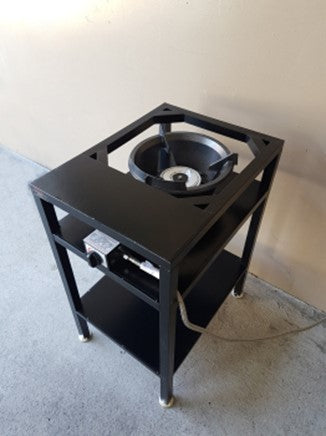
High-pressure wok burners are a step up from their low-pressure counterparts.
Operating at a high pressure of about 137.89 kilopascals, these burners also use natural gas or propane as fuel. Their design is more complex, necessitating professional installation and maintenance.
These burners are powerhouses, capable of generating heat ranging from 50,000 to 200,000 BTU per hour.
They are an excellent fit for large to extra-large woks and can handle advanced cooking tasks such as deep-frying, searing, or charring with ease.
The standout feature of high-pressure wok burners is their power and versatility.
They can generate the intense heat and flame required to achieve the “wok hei” effect, a hallmark of Asian cooking.
Additionally, they offer precise temperature control and flame adjustment capabilities, allowing you to enhance the flavour and texture of your dishes.
However, these burners come with their own set of challenges.
They are more expensive and complex compared to low-pressure burners.
Also, their fuel consumption is higher and they require a special gas line or regulator for operation, but this is a small price to pay for the benefits they offer and is worth the investment if your restaurant specialises in authentic Asian cuisine..
Stockpot burners
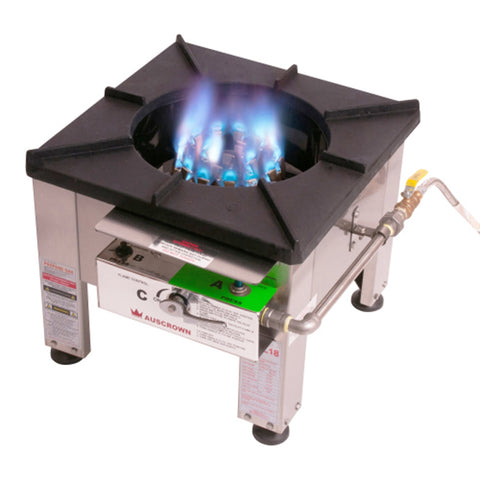
Stockpot burners are a unique category of wok burners, specifically designed to accommodate oversized pots and pans.
These burners can operate on natural gas or propane and function at either low or high pressure, depending on the specific model.
Their design is robust, making them easy to install and operate.
These burners can generate a moderate to high heat output, ranging from 20,000 to 80,000 BTU per hour.
They are an ideal choice for large to extra-large pots and pans, efficiently handling various cooking tasks such as boiling, stewing, or braising.
The primary advantage of stockpot burners is their durability and adaptability.
Their heavy-duty construction allows them to support heavy loads without tipping over.
Moreover, they can accommodate different sizes and shapes of cookware without compromising on heat distribution or efficiency.
However, they may not be able to generate the same level of heat or flame as regular wok burners, which could potentially impact the flavour and aroma of your food.
Additionally, their temperature control and flame adjustment capabilities are somewhat limited, which could affect the consistency of your dishes.
Commercial wok ranges

Commercial wok ranges represent the pinnacle of wok burner technology.
These burners can operate on natural gas or propane and function at either low or high pressure, depending on the specific model.
Their design is sophisticated, necessitating professional installation and maintenance.
These ranges can generate a variable heat output, ranging from 10,000 to 200,000 BTU per hour, making them suitable for any size or shape of woks, pots, pans, or other cookware.
They are capable of handling any cooking task you can imagine.
The standout feature of commercial wok ranges is their flexibility and multifunctionality.
They come equipped with multiple burners that can be configured according to your needs and preferences.
You have the option to choose between different types of burners, such as jet burner, ring burner, duck burner, etc., depending on the heat output and flame pattern you desire.
Additionally, you can choose between different types of ranges such as countertop, floor standing, wonton noodle range, noodle boiler, steamer, rice noodle boiler, etc., depending on the space and functionality you need.
However, these ranges do come with their own set of challenges.
They are more expensive and complex compared to other types of burners.
Their fuel consumption is higher, and they require a dedicated gas line or regulator for operation.
Moreover, they pose a higher risk due to multiple gas valves and connections that need to be checked and monitored regularly.
Waterless wok burners
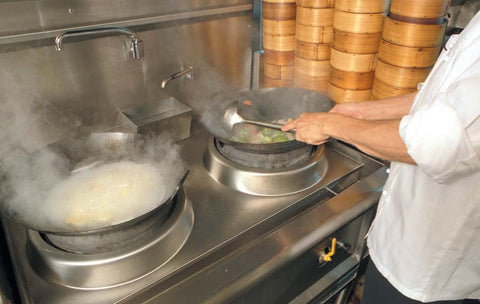
Waterless wok burners are a ground-breaking innovation in commercial cooking, designed to minimise water usage in commercial kitchens.
This not only makes them a more sustainable choice but also a cost-effective one.
These burners stand apart from traditional ones as they eliminate the need for water to cool the equipment.
This results in enhanced energy efficiency, as there’s no energy wasted on heating water.
Available in various models and sizes, these burners can be equipped with different types of burner heads, such as a 105Mj 24-jet chimney burner head or 110Mj 18-jet duck burner head.
This adaptability allows them to cater to diverse cooking needs and kitchen configurations.
The operation of waterless wok burners is based on an innovative air gap design that naturally cools the system, preventing overheating without the need for water.
One of their key advantages is their efficiency.
They heat up rapidly and maintain a consistent temperature, facilitating precise control over the cooking process.
However, due to their intricate design, they might necessitate more maintenance than traditional wok burners.
Styles of commercial wok burners
When it comes to commercial wok burners, the style of the burner plays a crucial role in determining its functionality and compatibility with different types of cookware.
The two primary styles are curved base wok burners and flat base wok burners, each with its unique design and applications.
Curved base wok burners
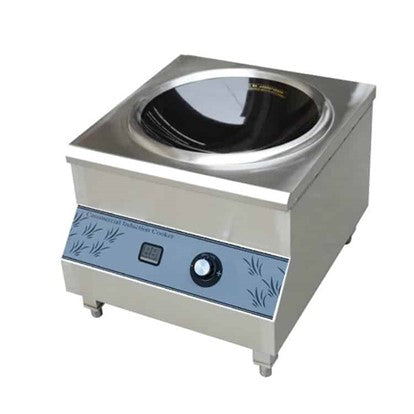
These burners are specifically designed to accommodate large woks with a curved base.
The concave design of the burner cradles the wok, allowing for even heat distribution across the base.
This makes them ideal for traditional stir-frying and other high-heat cooking techniques.
The curved base design also allows for easy tossing of ingredients, a common technique used in Asian cuisines.
Flat base wok burners
Contrarily, flat base wok burners are designed to work with woks that have a flat bottom.
The flat surface provides stability, ensuring the wok sits securely on the burner.
This style is versatile and can accommodate non-traditional cookware as well.
It’s a great choice for delicate cooking techniques or dishes that require consistent low-to-medium heat.
Your choice between a curved base and a flat base wok burner will depend on the type of wok you plan to use and the cooking techniques you commonly employ.
Both styles have their unique advantages and cater to different culinary needs.
Things to consider when buying a commercial wok burner
Choosing the right commercial wok burner is about finding a piece of equipment that can handle high temperatures, multitask efficiently, and cater to your unique cooking styles.
Let’s explore the key factors that will help you choose a wok burner that’s more than just a kitchen appliance but a true ally in your culinary endeavours.
Material
When it comes to the material of your commercial wok burner, it’s not just about aesthetics.
The material can influence the burner’s durability, heat distribution, and maintenance requirements.
Here are some common materials used in wok burners:
- Stainless steel: This is a popular choice due to its durability and resistance to rust and corrosion. Stainless steel can handle high temperatures and is easy to clean, making it a practical choice for busy commercial kitchens.
- Cast iron: Known for its excellent heat retention and distribution, cast iron is another common material used in wok burners. It’s highly durable but requires regular seasoning to prevent rusting.
- Brass: Brass burners are highly resistant to corrosion and provide precise heat control. They are often found in high-end models due to their longevity and performance.
- Aluminium: Aluminium burners are lightweight and heat up quickly. However, they may not be as durable as stainless steel or cast iron.
Each material has its own set of benefits and drawbacks.
Your choice will depend on your specific needs, such as the type of cooking you do, how often you use the burner, and your budget.
Size and weight compatibility
A wok burner is a beast, but even beasts need the right environment to thrive.
It’s not just about the burner itself but also about how well it fits into your kitchen setup.
- Size: The size of the burner should match the size of your wok. A burner that’s too small won’t heat the wok evenly, while a burner that’s too large may be inefficient.
Also, consider the space available in your kitchen.
Make sure there’s enough room for the burner and for you to move around comfortably while cooking.
- Weight: Commercial wok burners can be quite heavy, especially those made of cast iron or stainless steel. Ensure that your kitchen setup can support the weight of the burner.
Also, consider how often you’ll need to move the burner.
If it needs to be portable, look for a lighter model.
Fuel type/power source
To harness the full potential of a wok burner, the right fuel or power source is essential.
It’s not just about the heat, but also about compatibility with your kitchen setup and local regulations.
- Natural gas: Natural gas burners are common in commercial kitchens due to their high heat output and cost-effectiveness. However, they require a gas line installation, which may not be feasible in all locations.
- Propane: Propane burners are portable and can generate high heat, making them suitable for outdoor cooking or places without a natural gas supply. However, propane tanks need to be refilled regularly.
- Electric: Electric wok burners are easy to use and install, as they only require an electrical outlet. They offer precise temperature control but may not provide the same high heat as gas burners.
- Induction: Induction wok burners offer rapid heating and precise control over temperature settings. They are energy-efficient and safe to use as they only heat the wok, not the cooktop surface. However, they require special induction-compatible cookware.
Each fuel or power source has its pros and cons.
Your choice will depend on your specific needs, the setup of your kitchen, and local regulations.
Heat output
Whether you’re gently simmering a sauce or flash-frying a stir-fry, your wok burner should be able to deliver the right amount of heat.
Here’s a quick guide to help you understand what different BTU ratings mean for your cooking:
- Low BTU: Burners with a lower BTU rating (around 10,000 to 40,000 BTU) are great for slow cooking methods like simmering or stewing. They provide a gentle heat that can be easily controlled.
- Medium BTU: Burners in the medium range (around 40,000 to 80,000 BTU) offer more versatility. They can handle everything from frying and sautéing to quick boiling.
- High BTU: High BTU burners (80,000 BTU and above) are the real beasts of the kitchen. They provide intense heat that can sear meat to perfection or stir-fry vegetables in seconds.
The right BTU for you will depend on your specific cooking needs.
Ignition system
The ignition system of your wok burner is like the spark that brings.
It’s about how quickly and safely you can get your burner up and running.
Here are the common types of ignition systems:
- Manual ignition: This is the traditional method where you use a match or lighter to ignite the burner. It’s simple and doesn’t require any special equipment, but it does require caution to avoid burns.
- Automatic ignition: This system uses electricity to generate a spark that ignites the burner. It’s safe and convenient as it ignites the burner with the turn of a knob, eliminating the need for matches or lighters.
- Piezo ignition: This is a type of automatic ignition system that generates a spark when a button is pressed. It’s reliable and easy to use, making it a popular choice for many commercial wok burners.
Whether you prefer the simplicity of manual ignition or the convenience of automatic ignition, your wok burner should be able to spark into action with ease.
Safety features
Safety features are like the guardian angels of your commercial wok burner.
They ensure that your culinary adventures remain safe and accident-free. Here are some safety features to consider:
- Flame failure device: This safety feature automatically shuts off the gas supply if the flame goes out unexpectedly, preventing gas leakage.
- Thermostat control: A thermostat can regulate the burner’s temperature, preventing overheating and potential fire hazards.
- Cool-touch handles: These handles remain cool to the touch even when the burner is in use, protecting you from burns when adjusting the wok or pot.
- Stability features: Look for burners with sturdy bases or anti-tip features to prevent the wok from tipping over during use.
While a wok burner is a powerhouse in terms of performance, it should also be a gentle giant when it comes to safety.
Your chosen burner should not only meet your cooking needs but also prioritise your safety in the kitchen.
Ease-of-cleaning
Ease of cleaning is like the cool-down routine after a workout with your commercial wok burner.
It’s about how easily you can get your burner back in shape for the next session. Here are some factors to consider:
- Material: Some materials are easier to clean than others. For example, stainless steel is known for its resistance to staining and can be cleaned with a simple wipe-down.
- Removable parts: Burners with removable parts, such as grates or drip trays, make cleaning a breeze as you can reach all the nooks and crannies.
- Non-stick coating: A burner with a non-stick coating can prevent food from sticking and burning onto the surface, making it easier to clean.
- Cleaning method: Check if the burner is dishwasher-safe or requires hand washing. Some burners may also require specific cleaning solutions.
A clean wok burner is a happy wok burner.
Your chosen burner should not only meet your cooking needs but also make the clean-up process as hassle-free as possible.
Best makes of commercial wok burners
B+S
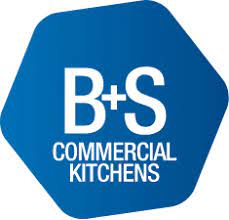
B+S Commercial Kitchens, an Australian family-owned business, began manufacturing commercial kitchen equipment in 1956.
Recognising the impact of Asian cuisine within the Australian food service industry by the late 1970s, they started to manufacture wok ranges to meet this demand.
They were the first Australian manufacturer to develop and manufacture a complete waterless wok range and have since added waterless steamers, stockpots, and HiPacs.
Two recommended models include the B+S Black Waterless HiPac Wok (Model No: CCF), touted as the most powerful Wok Cooker in Australia, and the B+S Single Hole Waterless Wok Burner (Model No: UFWWK-1), known for its space-saving design and maximised performance.
Both models are constructed with high-quality stainless steel and do not require water deck cooling, making them efficient and cost-effective.
Shop B+S commercial wok burners now.
Cooktek

CookTek, established in 1994, is a leading innovator in induction warming, cooking, and heated delivery systems for commercial kitchens and restaurants.
It is a highly recommended brand for commercial wok burners in Australia due to its commitment to quality, durability, and innovation.
They offer a wide range of products, including the CookTek MWG2500 Countertop Rotary-Dial Control Wok Cooker - 10 Amp and the CookTek MWG3500 Countertop Rotary-Dial Control Wok Cooker - 15 Amp.
The MWG2500 model features a durable stainless steel housing and an easy-to-clean glass-ceramic wok bowl. It comes with 20 power cook settings for precise cooking. Automatic pan detection quickly heats up when a pan is present.
The MWG3500 model, on the other hand, also boasts a portable countertop design with stainless steel housing and a recessed glass ceramic wok bowl intended for commercial kitchens and restaurants. It has an automatic shut-off feature, an integral cooling fan, and a self-diagnosing microprocessor, allowing for a safe kitchen environment.
Both models are known for their power and speed for more precise cooking, easy-to-clean surfaces, and energy-efficient technology and are available in countertop models.
Shop Cooktek commercial wok burners now.
Luus

Luus Industries, a well-known manufacturer of commercial catering equipment, was established in Sunshine, Victoria, Australia.
Their commercial wok burners are a popular choice in Australia thanks to their sturdy build, high heat output, and precise temperature controls.
These features make them perfect for quick and efficient stir-frying, deep-frying, and sautéing, and a must-have in any restaurant kitchen.
Among their offerings, the Luus 1 Air-Blast Burner Fo San Wok Burner – WV-1A and the Luus Single Hole Compact Waterless Wok Burner – WZ-1C stand out.
The WV-1A is an air-blast burner known for its high heat output, while the WZ-1C is a compact waterless wok burner designed for smaller kitchens.
Both models are praised for their even heat distribution and excellent cooking results.
Shop Luus commercial wok burners now.
Cobra by Moffat

Cobra by Moffat, a brand known for its uncompromised performance and reliable commercial kitchen equipment, is a popular choice in Australia.
Their commercial wok burners are appreciated for their power, versatility, and robust construction. The Cobra series of wok burners are designed to meet the ever-changing demands of the restaurant business, making them a perfect fit for any commercial kitchen.
Two standout models from their range are the Cobra CW2H-CC - 1200mm Gas Waterless Wok with 2 Chimney burners and the Cobra CW1H-D - 600mm Gas Waterless Wok with 1 Duckbill burner.
The CW2H-CC model is a waterless wok with two chimney burners, known for its compact design and high heat output.
The CW1H-D model is a waterless wok with a single duckbill burner, praised for its robust and long-lasting surface. Both models are designed to deliver excellent cooking results.
Shop Cobra commercial wok burners now.
Goldstein

Goldstein, an Australian stalwart in the commercial cooking equipment industry for over a century, is synonymous with quality and endurance.
Their commercial wok burners are a testament to their commitment to robust construction, energy efficiency, and adaptable burner configurations.
This makes them an indispensable asset for any commercial kitchen in Australia. The Goldstein CWA1 and the Goldstein CWA2 are two exceptional models that embody Goldstein’s ethos.
The CWA1 is a floor-mounted marvel with a 356mm diameter wok and a heavy-duty dual-ringed burner.
It boasts an air-cooled stainless steel cooking surface, a freshwater swivel tap, and flame failure protection.
The CWA2, a sibling of the CWA1, houses two 356mm diameter woks while maintaining the same impressive features.
Both models are designed to ensure culinary excellence.
Shop Goldstein commercial wok burners now.
Used commercial wok burners — worth considering?
Spending thousands of dollars on a commercial wok burner can put a strain on your budget and cash flow.
If you’d prefer not to invest a lot of money in a wok burner, a cheaper, pre-owned appliance might be the solution you’re looking for.
SilverChef’s range of ‘Certified Used’ commercial equipment is mostly ex-rental equipment sourced from businesses we know and trust.
The equipment is typically less than two-and-a-half years old, has been fully refurbished by us, and is backed by a three-month parts-and-labour warranty.
Considering the effective, or useful, life of a wok burner is much longer, you can be sure our Certified Used commercial wok burners have plenty of life left in it.
You can either buy or finance the ‘Certified Used’ (and clearance) equipment on our website. (We’re one of the few financiers, if not the only one, in Australia that funds second-hand commercial kitchen equipment).
Read more about ‘Certified Used’ equipment.
Frequently asked questions
How does a commercial wok burner work?
Commercial wok burners, whether they’re powered by gas or electricity, operate by releasing fuel through a valve.
This fuel is then ignited, which heats up the wok. The design of these burners allows for high heat and even distribution, making them ideal for a variety of cooking methods.
The ignition process can be either automatic or manual. Some models even feature a water cooling system for added safety.
How much does a commercial wok burner cost?
The cost of a commercial wok burner in Australia can vary greatly depending on the model and features.
Prices can range from around $1,850 for basic models to over $4,698 for high-end models with advanced features.
Some suppliers, like , offer a rent-to-buy option, with prices starting from $23.48 per week.
This can be a cost-effective solution for businesses looking to manage their cash flow. It’s always a good idea to compare prices and features from different suppliers to ensure you’re getting the best value for your money.
Is a commercial wok burner better than a normal burner?
In a commercial kitchen setting, the choice between a commercial wok burner and a normal burner depends on the specific cooking requirements.
Commercial wok burners are designed for high heat output, making them ideal for quick and efficient stir-frying, a common requirement in many commercial kitchens.
On the other hand, normal burners provide a consistent and moderate flame output, suitable for regular cooking tasks such as boiling and simmering.
Therefore, in a commercial kitchen that frequently prepares dishes requiring high heat, like stir-fries or seared meats, a commercial wok burner would be a valuable addition.
Commercial wok burners glossary
BTU (British Thermal Unit)
A unit of heat energy. One BTU is the amount of heat required to raise the temperature of one pound of water by one degree Fahrenheit.
In Australian units, 1 BTU is approximately equal to 1.055 Kilojoules.
Piezo ignition
A type of ignition system that generates a spark when a button is pressed, igniting the gas.
Thermostat control
A feature that regulates the burner’s temperature, preventing overheating and potential fire hazards.
Non-stick coating
A surface coating that prevents food from sticking and burning onto the burner, making it easier to clean.
Drip tray
A removable part of the burner that catches food drippings or excess oil, making cleaning easier.
Anti-tip feature
A safety feature designed to prevent the wok from tipping over during use.
Jet burner
A type of burner known for its high heat output and fast heating times.
Ring burner
A type of burner that provides even heat distribution, ideal for slow cooking methods.
Duck burner
A type of burner that provides intense heat and is often used for searing or charring food.
Wonton noodle range
A type of range designed for cooking wonton noodles, featuring a high BTU output and a large cooking area.
Noodle boiler
A type of range designed for boiling noodles, featuring multiple compartments for cooking different types of noodles simultaneously.
Rice noodle boiler
A type of range designed specifically for cooking rice noodles, featuring a high BTU output and a large cooking area.
Keep your cash, use ours!
We hope this guide has helped you better understand what you need to look for in a commercial wok burner and how to choose the right model for your needs. If you want to know more, you can always reach out to the SilverChef team.
Hospitality equipment can be expensive, and paying for it outright can put pressure on your business’s cash flow.
Our finance solutions allow you to get the equipment you want now and to pay for it in small, regular amounts out of the revenue it generates for you.
Rent–Try–Buy® not only helps you maintain your cash flow, it gives you unrivalled flexibility to adapt your equipment to the changing needs of your business.
You can upgrade or buy the equipment at any time or, after 12 months, return or continue renting it.
If you decide to buy the equipment, we’ll give you back 75% of the net rent you paid in the first year and 25% of any rental payments thereafter — to put toward the purchase price.

